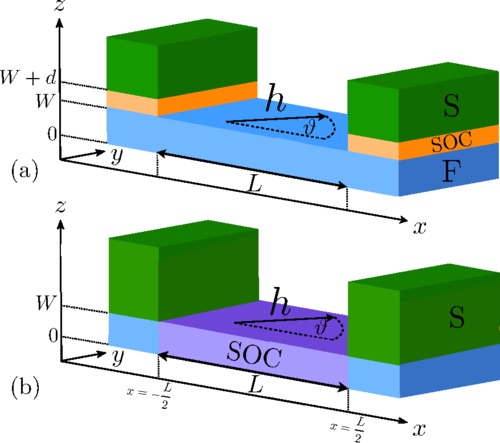We study the Josephson current in two types of lateral junctions with spin-orbit coupling and an exchange field. The first system (type 1 junction) consists of superconductors with heavy metal interlayers linked by a ferromagnetic bridge, such that the spin-orbit coupling is finite only at the superconductor/heavy metal interface. In the second type (type 2) of system we assume that the spin-orbit coupling is finite in the bridge region. The length of both junctions is larger than the magnetic decay length such that the Josephson current is carried uniquely by the long-range triplet component of the condensate. The latter is generated by the spin-orbit coupling via two mechanisms, spin precession and inhomogeneous spin relaxation. We show that the current can be controlled by rotating the magnetization of the bridge or by tuning the strength of the spin-orbit coupling in type 2 junctions and also discuss how the ground state of the junction can be tuned from a 0 to a π phase difference between the superconducting electrodes. In leading order in the spin-orbit coupling, the spin precession dominates the behavior of the triplet component and both junctions behave similarly. However, when spin relaxation effects are included the type 2 junction offers a wider parameter range in which 0-π transitions take place.

We study the Josephson current in two types of lateral junctions with spin-orbit coupling and an exchange field. The first system (type 1 junction) consists of superconductors with heavy metal interlayers linked by a ferromagnetic bridge, such that the spin-orbit coupling is finite only at the superconductor/heavy metal interface. In the second type (type 2) of system we assume that the spin-orbit coupling is finite in the bridge region. The length of both junctions is larger than the magnetic decay length such that the Josephson current is carried uniquely by the long-range triplet component of the condensate. The latter is generated by the spin-orbit coupling via two mechanisms, spin precession and inhomogeneous spin relaxation. We show that the current can be controlled by rotating the magnetization of the bridge or by tuning the strength of the spin-orbit coupling in type 2 junctions and also discuss how the ground state of the junction can be tuned from a 0 to a π phase difference between the superconducting electrodes. In leading order in the spin-orbit coupling, the spin precession dominates the behavior of the triplet component and both junctions behave similarly. However, when spin relaxation effects are included the type 2 junction offers a wider parameter range in which 0-π transitions take place.
